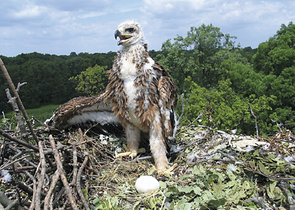Nature Conservation 1/2009 — 20. 2. 2009 — Research, Surveys and Data Management — Print article in pdf
The Eastern imperial Eagle (Aquila heliaca) in the South Moravia

The Eastern Imperial Eagle (Aquila heliaca) has been a new, resident breeding species in the Czech Republic since 1998, as a result of its population increase in Hungary and Slovakia. Since then, 1-3 pairs breed annually.
The nest site is situated on the border with Slovakia and Austria, but the raptor’s feeding grounds are located in Austria. In 1998-2008, 20 breeding attempts took place, 14 of them were successful (in total, 24 young fledged). In 19 nestings, where egg-laying was confirmed, the average clutch size was 2.19, number of hatched chicks 1.47 and number of fledged young 1.26 (1.71 per productive breeding). The average nest height was 25.4 m (18-34 m, N=17). Nests were built on Quercus (10), Populus (6) and Pinus (1); the age of forest was 100–150 years (oak, pine) or 40-60 years (poplar). 109 prey items of 20 species were identified in the Eastern Imperial Eagle’s diet: 9 mammals (82 items), 10 birds (26) and 1 amphibian (1). The most important were: the Common Hare Lepus europaeus (45) and Common Hamster C. cricetus (19), Common Pheasant Phasianus colchicus (10), European Roe Deer C. capreolus (carcasses, 5) and small rodents (Common Vole, Microtus arvalis, 6). Nest-building begins in November-December. Egg-laying occurs from late March until mid-April. Successful breeding at the age of 2 (male) and 4 years (female) was confirmed. In one case, presumed replacement clutch was laid at the beginning of May. Nest stability is a serious problem, because windstorms regularly occur there in June or July. In 4 cases, young or the whole nests fell down in the windstorms; 4 young died, 6 young were put back into the nests and survived. Other reasons of nesting failure include disturbance by forestry (3) or tourism (1); in 2 cases, birds were probably infertile. During the winter 2007-2008, the numbers of the Eastern Imperial Eagle considerably increased in the breeding area; up to 10 birds (mainly juveniles and immatures) stayed at the communal roost, along with up to 30 White-tailed Eagles (Haliaeetus albicilla).

